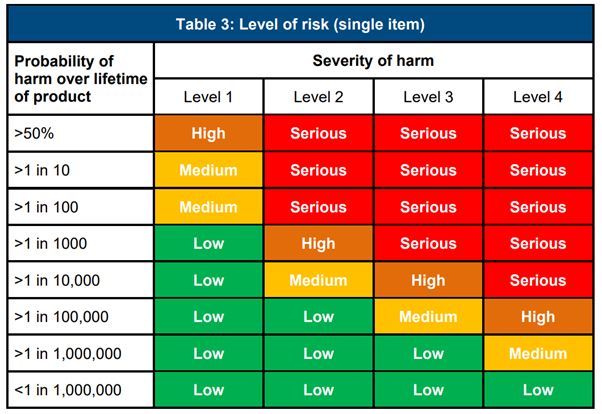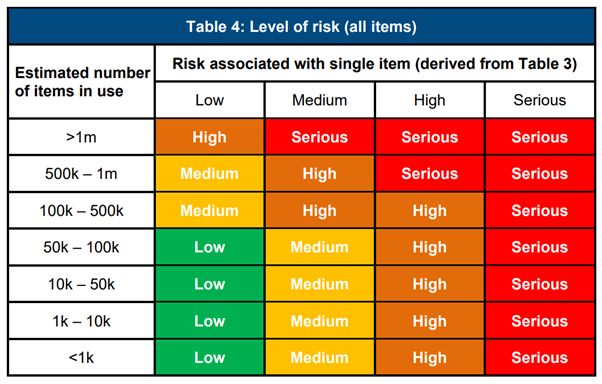The UK Office for Product Safety & Standards (OPSS) (the national product safety regulator) has published its new Product Safety Risk Assessment Methodology called "PRISM" to replace the EU RAPEX methodology for the GB market. While it is based on the EU RAPEX methodology, it contains a number of new elements, and manufacturers will have real concerns that the risks assessments may produce different results, especially involving larger populations of products. This could lead to expectations of more stringent corrective actions in the UK market.
What is it?
PRISM has been designed by OPSS to replace the EU RAPEX methodology for the GB market (i.e. England, Scotland and Wales) for risk assessments where marketed products are found to be non-compliant or present a risk.
It is for use by GB Market Surveillance Authorities, who will be adopting PRISM from the start of December 2022 as part of a "soft transition" from EU RAPEX to PRISM that will last 6 months. We understand that from launch, the OPSS (national regulator) will start using PRISM and Trading Standards may choose to start using it at a local level. After 6 months, it is expected that all GB regulators will transition over. RAPEX will still be used for the NI market (due to the Northern Ireland Protocol).
Businesses can choose to adopt the methodology or use elements of PRISM to enhance their own processes. In practice, businesses will need to anticipate that the regulatory authorities in the UK will be using the PRISM methodology, which means it is in the business' interests to use that same model, rather than simply leave it to the UK regulator to do so based on more limited information available to them.
In addition to the risk assessment methodology, PRISM also formalises the process for risk triage and the risk evaluation. The accompanying guide also provides guidance on risk assessing multiple hazards, use of data, people at increased risk, testing and product homogeneity, relative risk, factors that influence how risks is perceived, applying the "Precautionary Principle" and psychological harm.
What products does it apply to?
Most non-food consumer products – with a number of exclusions including medical products and medical devices.
The accompanying guide notes that for certain products there may be circumstances where alternative risk assessment methodologies are more suitable (with cosmetics and chemicals listed as potential examples). For construction products, online guidance notes PRISM can be used in the context of construction products, however the OPSS is currently considering whether to develop a version of PRISM specifically geared towards construction products.
Why does it matter?
PRISM encompasses the EU RAPEX methodology (risk presented by a single product). However, at the risk assessment stage PRISM also takes into account additional factors including the number of products in use in the UK to inform the appropriate corrective action.
Below are the tables from the accompanying guide showing the adjustment to the level of risk having regard to the number of products in use in the UK. This creates a real risk that companies running international recalls will find that their risk assessment of the same products sold across the EU and the UK indicates a higher risk in the UK than in the EU markets. As a result we could see different approaches to recalls and other corrective actions in the UK compared with the rest of Europe, as well as a risk of confusing and inconsistent messages in the public communications.


Certain products and hazards will be deemed to present a serious risk (under a rebuttable presumption) without the need for a risk assessment. This includes certain chemical risks, category III PPE (where it is non-compliant for any reason, with labelling listed as an example) and products assessed by OPSS as a serious risk.
In relation to the number of steps in a harm scenario, the accompanying guide notes that the number of steps should be kept to a minimum and it would be rare for more than five steps to be necessary.
Online guidance includes links to open-source data sets that would be helpful to support a risk assessment – such as fire and accident statistics.
What is next?
PRISM is initially presented as an excel document, with an online digital tool to follow in 2023.
The OPSS will monitor the roll-out over the next 6 months to see how PRISM performs. It has encouraged users to share their feedback and have said that they will assess the effectiveness of PRISM to ensure it achieves the desired outcomes.
Where can I find out more?
- Short form online guidance, link to PRISM tool and links to open source data sets are available here
- Guide for GB Market Surveillance Authorities and Enforcing Authorities Responsible for Regulating Consumer Product Safety on using PRISM is available here
- Guidance PRISM: Products and Hazards Deemed Serious Risk here
The content of this article is intended to provide a general guide to the subject matter. Specialist advice should be sought about your specific circumstances.



